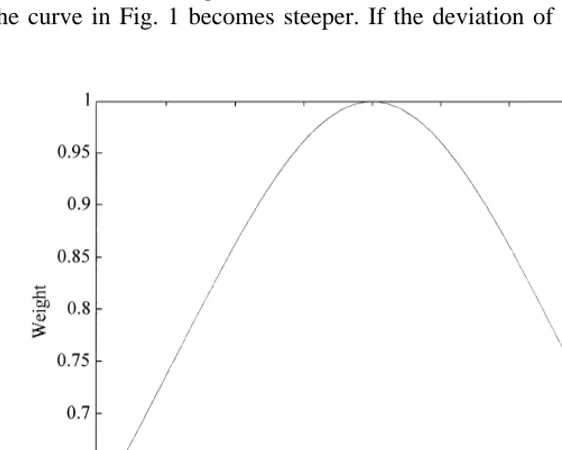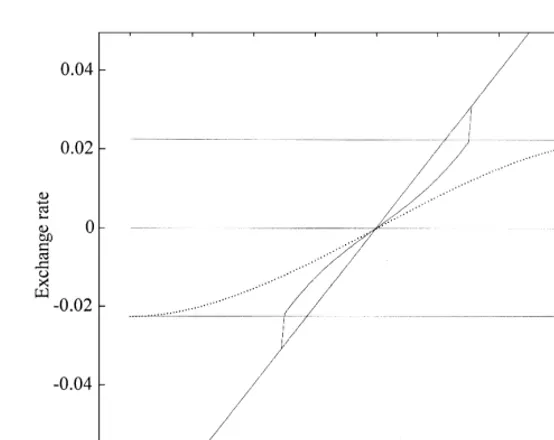www.elsevier.com / locate / econbase
An heterogeneous expectations target zone model
*
´
Jose L. Torres
Department of Economics, University of Malaga, El Ejido s /n, 29013 Malaga, Spain
Received 30 December 1998; accepted 23 September 1999
Abstract
This paper studies the credibility of a target zone considering the existence of heterogeneous expectations in the foreign exchange market. In general, we consider two types of agents: credible and non-credible agents (i.e. fundamentalists). One of the main results of the model is the possibility of collapse of a target zone as a function of expectations. This implies the existence of an endogenous realignment risk. 2000 Elsevier Science S.A. All rights reserved.
Keywords: Exchange rates; Target zones; Heterogeneous expectations
JEL classification: F31; F33
1. Introduction
This note studies the credibility of an exchange rate target zone assuming the existence of heterogeneous expectations in the foreign market, in the spirit of the model developed by Frankel and Froot (1990). The main characteristic of standard target zone models is the fact that agents firmly believe the declared policy of keeping the exchange rate within a fluctuation band. As a main consequence the target zone stabilizes exchange rate behavior as a function of its fundamentals. This is the so-called honeymoon effect. However, if we look at exchange markets, there are several agents who cannot believe in the honeymoon effect, especially if they perceive serious deviations of the fundamentals from their equilibrium value. As evidence shows, actual target zone systems have proven to be unsustainable, implying that we have to consider the possibility of target zones as being non-fully credible regimes.
We propose a new target zone model based on the existence of two types of agents in the foreign market: credible and non-credible (i.e. fundamentalists). From the model we obtain that the
*Tel.:134-95-213-1247; fax: 134-95-213-1299. E-mail address: [email protected] (J.L. Torres)
probability of collapse of the target zone is a function of expectations. This implies the existence of an endogenous realignment risk.
2. Credible and non-credible target zones
2.1. The model
Using the standard monetary model of exchange rate determination we obtain the following solution for the (log of the) exchange rate, s :t
E (ds )t t
]]
st5ft1a dt , (1)
where the exchange rate is equal to the fundamentals, f , plus the expected change in the exchanget rate, E (ds ) / dt, and wheret t a is the interest rate semi-elasticity. The exchange rate is restricted to
]
moving in the space (s,s), defining the lower and the upper limits of fluctuation, respectively.] Monetary authorities intervene at the margins of fluctuation. As usual, we assume that the fundamentals follow Brownian motion, with drift m and a standard deviation of s:
dft5mdt1sdz ,t (2)
where z is a Weiner process.t
We assume the existence of two types of agents in order to study the implications of market credibility on target zones. The first type of agents are denominated credible agents as they consider the target zone as a credible regime, that is, they assume that the monetary authorities’ declared policy of keeping the current fluctuation band fixed is completely credible. The second group of agents are non-credible agents, as they do not believe in the stabilizing effect of the target zone and they expect a realignment of the central parity if the divergences of the fundamentals are large enough.
Considering the existence of these two groups of agents, we can rewrite the exchange rate equation (1) as
EC,t(ds )t ENC,t(ds )t
F
]]] ]]]G
st5ft1a wt dt 1(12w )t dt , 0#wt#1, (3)
where EC,t(ds ) / dt represents the expectations of the agents who consider the target zone as fullyt
credible, ENC,t(ds ) / dt represents the expectations of the agents who do not believe in the target zonet regime, and w is the weight for the different agents [w and (1t t 2w ) are the weights for the crediblet
2.2. The weight scheme
We assume that the weight of each type of agent in the foreign market depends on the deviations of the fundamentals from their equilibrium value, defined by the central parity for the exchange rate. If there is no deviation, all agents behave as credible agents. As deviations increase, agents become non-credible. Therefore, w is a decreasing function of deviations of the fundamentals from theirt equilibrium value. Following De Grauwe and Dewachter (1992) we use the following expression for
1 the weight:
1 ]
]]]
wt5 2 if s]#st#s,
11g(h )t (4)
]
wt50 if st.s, st,s,]
where h is the deviation of the fundamentals with respect to their equilibrium value andt g .0 is a parameter that determines the speed with which the weight of the credible agents declines. Therefore, the weight can be considered as a measure of the credibility of the target zone regime and depends on
h . If ht t50, then wt51 (fully credible target zone). As h moves away from zero (the equilibriumt
value of the fundamentals), w starts to decline.t
Fig. 1 shows the evolution of weight in relation to the deviation of the fundamentals forg5100. With a high g the curve in Fig. 1 becomes steeper. If the deviation of the fundamentals is zero, the
Fig. 1. The weight scheme.
1
weight is one. As the deviation of the fundamentals increases, the weight of the agents who believe in the credibility of the target zone decreases and the weight of the non-believing agents increases.
3. Credible and fundamentalist agents
Using the model developed above, we can analyze the dynamics of the exchange rate in a target zone via the existence of two types of agents in the market: credible and fundamentalist agents. First, we only consider credible agents, generating the well-known S-shaped behavior of the exchange rate with respect to the fundamentals. Assuming that the exchange rate function has second derivatives, and applying Ito’s lemma, we obtain
EC,t(ds )t E (df )t t 1 E (df )t t
]]]dt 5sf]]dt 1]2sff]]dt . (5)
Hence, the solution for the exchange rate in this scenario is the standard target zone solution (see Krugman, 1991):
st5am1ft1A exp(1 l1 tf )1A exp(2 l2 tf ), (6)
where the constants A and A have to be determined by the smooth-pasting conditions and1 2 l1 andl2 are the roots of the characteristic equation. Therefore, this type of agent expects interventions at the margins in order to keep the exchange rate within the band and also expects a depreciation of the exchange rate below the central parity and vice versa. The expected depreciation (appreciation) increases as the deviation of the fundamentals increases in a non-linear way.
However, not all agents in the exchange market may consider this policy as credible. The second type of agent does not believe in the target zone and its expected change in the exchange rate is proportional to the difference between the current exchange rate and its fundamentals. In this case, they disregard the existence of a fluctuation band and treat the regime as a free float system. The solution for the exchange rate of this agent is the standard free float solution:
st5am1f .t (7)
The expected change in the exchange rate can be set as follows:
ENC,t(ds )t
]]] 5u( ft211am2st21), (8)
dt
where u is an adjustment parameter. If the exchange rate is above its fundamentals, they expect an appreciation and vice versa.
Given both types of agents, assuming that the drift is zero, the exchange rate solution is
st5ft1w [A exp(t 1 l1 tf )1A exp(2 l2 tf )]1a(12w )t u( ft212st21). (9)
Fig. 2. The exchange rate in a non-fully credible target zone.
Fig. 2 shows the dynamics of the exchange rate as a function of the fundamentals in the standard target zone solution (dotted line), the free float solution (458line), and when both types of agents exist
2
in the market, with g5100 andu55. The model works as follows. When the fundamentals are at their equilibrium level, wt51, all agents can be considered as credible agents and the expected change in the exchange rate is zero. On the upper side of the band, as fundamentals increase, the credible agents expect an appreciation in the exchange rate, whereas the fundamentalist agents expect a depreciation. Both expectations are non-linear, resulting in a non-linear behavior of the exchange rate in relation to the fundamentals with an inverted S-shape, but with the exchange rate always below its fundamentals. As we can see, on the upper side of the band the exchange rate is below the 458line (representing the fundamentals), implying that in spite of the existence of fundamentalist agents, when the deviations of the fundamentals are small, the target zone stabilizes the exchange rate. However, when the deviations are large enough, the expectations of the fundamentalists are more important than the expectations of the credible agents and the exchange rate reacts more than proportionally with respect to the fundamentals. This behavior is caused by the fact that when deviations of the fundamentals are small, the weight of credible agents is high compared to the fundamentalists. However, if deviations are large, the weight of the fundamentalists becomes more important. Finally, when the exchange rate reaches the upper limit, no agent believes in the zone, followed by the collapse of the zone as the market moves to the free float solution. Therefore, the exchange rate presents an initial undershooting, but as divergences in the fundamentals increase, this becomes an overshooting. Also, note that the fundamentals bandwidth is lower than in the fully credible case.
2 ]
4. Conclusions
In this note we have presented the dynamics of the exchange rate in a target zone when considering the existence of different types of agents in the foreign markets. One of the main results of the model is the possibility of target zone collapse as a consequence of the formation of expectations, which implies an endogenous realignment risk. From the model we obtain that the target zone stabilizes the exchange rate only for small divergences in the fundamentals. However, if the divergences are larger, the target zone collapses. Looking at the evolution of several currencies in the Exchange Rate Mechanism of the European Monetary System, we observe that this model can explain the evolution of the exchange rates in a target zone. For most of these currencies we observe that they behave in quite a stable way inside the band during a given period, in spite of the existence of deviations in the fundamentals. However, after that period of stability, if the deviations of the fundamentals are significant and permanent, the exchange rate depreciates rapidly until it reaches the upper limit and the zone collapses (see, for instance, Bertola and Caballero, 1992). These facts are similar to the results obtained from the model.
Acknowledgements
´
I would like to thank C. Gamez, B. Moreno and A. Morales for very useful comments. All errors remain my own.
References
Bertola, G., Caballero, R., 1992. Target zone realignments. American Economic Review 82, 520–536.
De Grauwe, P., Dewachter, M., 1992. Chaos in the Dornbusch model of the exchange rate. Kredit und Kapital 25, 26–54. Frankel, J., Froot, K., 1990. Understanding the US dollar in the eighties: the expectation of chartist and fundamentalists. The
Economic Record 62, 24–38.

